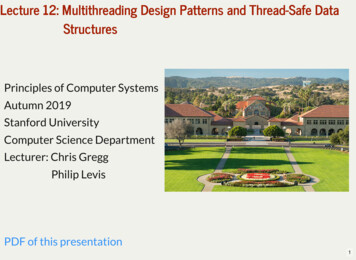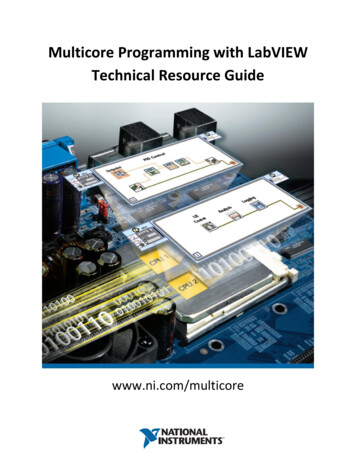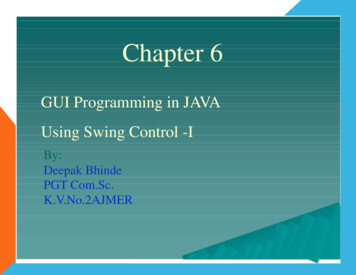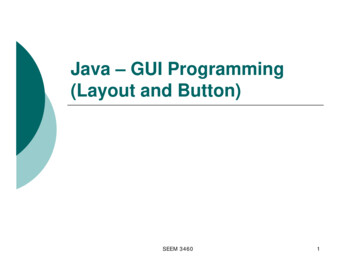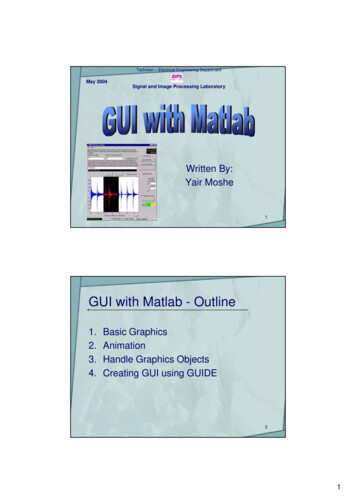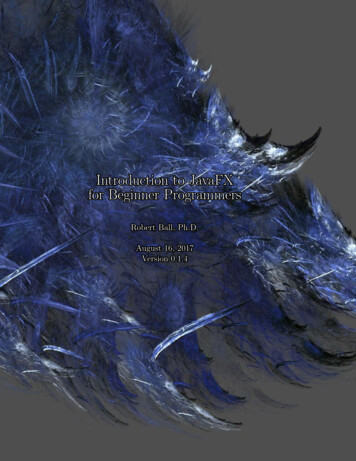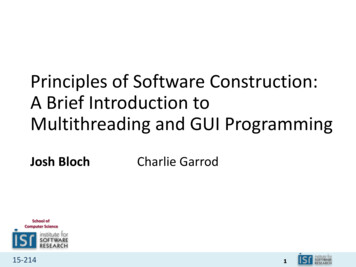
Transcription
Principles of Software Construction:A Brief Introduction toMultithreading and GUI ProgrammingJosh BlochCharlie GarrodSchool ofComputer Science15-2141
Administrivia Homework 4b due next ThursdayHW 3 feedback pushed this morning.HW 4a feedback available later this weekLast day to register to vote is TODAY15-2142
Key concepts from Thursday Class invariants must be maintained– Make defensive copies where required Immutable class have many advantages Testing is critical to software quality– When fixing bugs, write tests before code– Good tests have high power-to-weight ratio15-2143
Outline Multithreaded Programming basics GUI Programming15-2144
What is a thread? Short for thread of execution Multiple threads run in same program concurrently Threads share the same address space– Changes made by one thread may be read by others Multithreaded programming– Also known as shared-memory multiprocessing15-2145
Threads vs. processes Threads are lightweight; processes heavyweight Threads share address space; processes have own Threads require synchronization; processes don’t– Threads hold locks while mutating objects It’s unsafe to kill threads; safe to kill processes15-2146
Why use threads? Performance in the face of blocking activities– Consider a web server Performance on multiprocessors Cleanly dealing with natural concurrency In Java threads are a fact of life– Example: garbage collector runs in its own thread15-2147
Example: generating cryptarithmsstatic List String cryptarithms(String[] words, int start, int end) {List String result new ArrayList ();String[] tokens new String[] {"", " ", "", " ", ""};for (int i start; i end - 2; i ) {tokens[0] words[i]; tokens[2] words[i 1];tokens[4] words[i 2];try {Cryptarithm c new Cryptarithm(tokens);if (c.solve().size() 1)result.add(c.toString());} catch (IllegalArgumentException e) {// too many letters; ignore}}return result;}15-2148
Single-threaded driverpublic static void main(String[] args) {long startTime System.nanoTime();List String cryptarithms cryptarithms(words, 0, words.length);long endTime System.nanoTime();System.out.printf("Time: %ds%n”, (endTime - 15-2149
Multithreaded driverpublic static void main(String[] args) throws InterruptedException {int n Integer.parseInt(args[0]); // Number of threadslong startTime System.nanoTime();int wordsPerThread words.length / n;Thread[] threads new Thread[n];Object[] results new Object[4];for (int i 0; i n; i ) { // Create the threadsint start i 0 ? 0 : i * wordsPerThread - 2;int end i n-1 ? words.length : (i 1) * wordsPerThread;int j i; // Only constants can be captured by lambdasthreads[i] new Thread(() - {results[j] cryptarithms(words, start, end);});}for (Thread t : threads) t.start();for (Thread t : threads) t.join();long endTime System.nanoTime();System.out.printf("Time: %ds%n”, (endTime - (results));}15-21410
Cryptarithm generationperformanceNumber of ThreadsSeconds to run123422.013.511.710.8Generating all cryptarithms from a corpus of 344 words Test all consecutive 3-word sequences (342 possibilities) Test machine is this crappy old laptop (2 cores, 4 hyperthreads) I did not follow benchmarking best practices!15-21411
What requires synchronization? Shared mutable state If not properly synchronized, all bests are off! You have three choices1. Don’t mutate: share only immutable state2. Don’t share: isolate mutable state in individual threads3. If you must share mutable state, synchronize properly15-21412
Synchronization is tricky Too little and you risk safety failure– Changes aren’t guaranteed to propagate thread to thread– Program can observe inconsistencies– Critical invariants can be corrupted Too much and program may run slowly or not at all– Deadlock or other liveness failure15-21413
Contention kills performance Synchronized is the opposite of concurrent! Highly concurrent code is possible to write– But it’s very difficult to get right– If you get it wrong you’re toast Let Doug Lea write it for you!– ConcurrentHashMap– Executor framework– See java.util.concurrent15-21414
Safety vs. liveness Safety failure – incorrect computation– Can be subtle or blatant Liveness failure – no computation at all Temptation to favor liveness over safety– Don’t succumb! Safety failures offer a false sense of security Liveness failures force you to confront the bug15-21415
Synchronization in cryptarithm example How did we avoid synchronization in ourmultithreaded cryptarithm generator? Embarrassingly parallelizable computation Each thread is entirely independent of the others– They try different cryptarithms– And write results to different array elements No shared mutable state to speak of– Main thread implicitly syncs with workers with join15-21416
Outline Multithreaded Programming GUI Programming15-21417
There are many Java GUI frameworks AWT – obsolete except as a part of SwingSwing – the most widely used, by farSWT – Little used outside of EclipseJavaFX – Billed as a replacement for Swing– Released 2008 – has yet to gain traction A bunch of modern (web & mobile) frameworks– e.g., Android15-21418
GUI programming is multithreaded Event-driven programming Event dispatch thread (EDT) handles all GUI events– Mouse events, keyboard events, timer events, etc. Program registers callbacks (“listeners”)– Function objects invoked in response to events– Observer pattern15-21419
Ground rules for GUI programming1. All GUI activity is on event dispatch thread2. No other time-consuming activity on this thread– Blocking calls (e.g., I/O) absolutely forbidden Many GUI programs violate these rules– They are broken Violating rule 1 can cause safety failures Violating rule 2 can cause liveness failures15-21420
Ensuring all GUI activity is on EDT Never make a Swing call from any other thread Swing calls includes Swing constructors If not on EDT, make Swing calls with invokeLater:public static void main(String[] args) {SwingUtilities.invokeLater(() - new Test().setVisible(true));}15-21421
Callbacks execute on the EDT You are a guest on the Event Dispatch Thread! Don’t abuse the privilege If you do, liveness will suffer– Your program will become non-responsive– Your users will become angry If a few ms of work to do, do it off the EDT– javax.swing.SwingWorker designed for this purpose15-21422
DEMO – JDICE15-21423
Jdice – (a) DieType/** A game die type. Can also be used as a stateless game die. */public enum DieType {d4(4, 3), d6(6, 4), d8(8, 3), d10(10, 5), d12(12, 5), d20(20, 3);private final int sides; // Number of facesprivate final int edges; // Number of edges on each faceDieType(int sides, int edges) {this.sides sides;this.edges edges;}public int sides() { return sides; }public int edges() { return edges; }private static final Random random new Random();public int roll() { return random.nextInt(sides) 1; }public int roll(Random rnd) { return rnd.nextInt(sides) 1; }}15-21424
JDice – (b) Die (Part 1 of 2)/** A single, stateful game die. */public class Die {private final DieType dieType;private int lastRoll 1;public Die(DieType dieType) { this.dieType dieType; }public DieType dieType() { return dieType; }public int roll() { return lastRoll dieType.roll(); }public int roll(Random rnd) {return lastRoll dieType.roll(rnd);}public int lastRoll() { return lastRoll; }15-21425
JDice – (b) Die (Part 2 of 2)/** Returns array of Die per the std string spec (e.g., "d12", "2d6"). */public static Die[] dice(String spec) {DieType dieType;int numDice;int dPos spec.indexOf('d');if (dPos 0) {numDice 1;dieType DieType.valueOf(spec);} else {numDice Integer.parseInt(spec.substring(0, dPos));dieType DieType.valueOf(spec.substring(dPos));}Die[] result new Die[numDice];for (int i 0; i numDice; i )result[i] new Die(dieType);return result;}15-21426
JDice – (c) JDie (Part 1 of 4)/** GUI game die component that provides a view on a Die. */public class JDie extends JComponent {private Die die;public JDie(Die die) { this.die die; }@Override protected void paintComponent(Graphics g) {super.paintComponent(g); // Boilerplate// Get our size from containing component and compute center pointint componentWidth getWidth();int componentHeight getHeight();int centerX componentWidth / 2;int centerY componentHeight / 2;// Get Graphics 2D object - lets us do actual drawingGraphics2D g2d (Graphics2D) g;g2d.setRenderingHint(RenderingHints.KEY ANTIALIASING,RenderingHints.VALUE ANTIALIAS ON);15-21427
JDice – (c) Jdie (Part 2 of 4)paintComponent, cont.// Draw the face outlineg2d.setColor(Color.BLACK);g2d.setStroke(new BasicStroke(4, BasicStroke.CAP ROUND,BasicStroke.JOIN ROUND));double r .4 * Math.min(componentWidth, componentHeight);Path2D path polygon(die.dieType().edges(), centerX, centerY, r);g2d.draw(path);// Fill the face outlineg2d.setColor(Color.RED);g2d.fill(path);// Draw the number on the faceg2d.setColor(Color.WHITE);Font font g2d.getFont();g2d.setFont(font font.deriveFont(Font.BOLD, 3 * font.getSize()));String number g(g2d, number, centerX, centerY);}15-21428
JDice – (c) JDie (Part 3 of 4)helper method polygon/** Returns a polygonal path with an edge parallel to X axis. */static Path2D polygon(int edges, int ctrX, int ctrY, double r) {// Compute angle of first point in polygon pathdouble theta0 -Math.PI / 2;if ((edges & 1) 0)theta0 Math.PI / edges; // Even # of sidesPath2D path new Path2D.Double();for (int i 0; i edges; i ) {double theta theta0 i * 2 * Math.PI / edges;double x ctrX r * Math.cos(theta);double y ctrY r * Math.sin(theta);if (i 0)path.moveTo(x, y);elsepath.lineTo(x, y);}path.closePath();return path;}15-21429
JDice – (c) JDie (Part 4 of 4)helper method drawCenteredString/** Prints a string centered at the given point */static void drawCenteredString(Graphics2D g2d, String text, int x, int y) {Rectangle stringBounds g2d.getFontMetrics().getStringBounds(text, g2d).getBounds();GlyphVector glyphVector ontext(), text);Rectangle visualBounds String(text, x - stringBounds.width / 2,y - visualBounds.height / 2 - visualBounds.y);}15-21430
JDice – (d) JDice/** GUI game dice panel that provides a view on a Die array. */public class JDice extends JPanel {public JDice(Die[] dice) {setLayout(new GridLayout(1, dice.length, 5, 0));for (Die d : dice)add(new JDie(d));}public void resetDice(Die[] dice) {removeAll();for (Die d : dice)add(new JDie(d));revalidate(); // Required boilerplaterepaint();}}15-21431
JDice – (e) Demo (Part 1 of 2)public class Demo extends JFrame {String diceSpec "2d6"; // Default dice spec.Die[] dice Die.dice(diceSpec);JDice jDice new JDice(dice);private Demo() {setDefaultCloseOperation (WindowConstants.EXIT ON CLOSE);setSize(600, 300); // Default dimensions// Implement roll button and dice type fieldJTextField diceSpecField new JTextField(diceSpec, 5); // Field widthJButton rollButton new JButton("Roll");rollButton.addActionListener(event - { // Callback!if (!diceSpecField.getText().equals(diceSpec)) {diceSpec diceSpecField.getText();dice Die.dice(diceSpec);jDice.resetDice(dice);}for (Die d : dice) d.roll();jDice.repaint();});15-21432
JDice – (e) Demo (Part 2 of 2)// End of constructor: build roll panel and content paneJPanel rollPanel new JPanel(new el.add(rollButton);getContentPane().add(jDice, l, BorderLayout.SOUTH);}public static void main(String[] args) {SwingUtilities.invokeLater(() - new Demo().setVisible(true));}}15-21433
Observations on JDice GUI programming is a bit tedious The Swing APIs are huge And yet you still have to do a lot yourself– e.g., drawing polygons, centering text properly– Doing it well takes a lot of effort Getting the threading right isn’t that hard– So do it15-21434
For help writing Swing code Sun wrote a good tutorial– http://docs.oracle.com/javase/tutorial/uiswing/ The many components shown with examples– ponents/componentlist.html Listeners supported by each component– nts/eventsandcomponents.html15-21435
Summary Multithreaded programming is genuinely hard– But it’s a fact of life in Java Neither under- nor over-synchronize– Immutable types are your best friend– java.util.concurrent is your next-best friend GUI programming is limited form of multithreading– Swing calls must be made on event dispatch thread– No other significant work should be done on EDT15-21436
Multithreaded programming is genuinely hard – But it’s a fact of life in Java Neither under- nor over-synchronize – Immutable types are your best friend – java.util.concurrent is your next-best friend GUI programming is limited form of multithre
